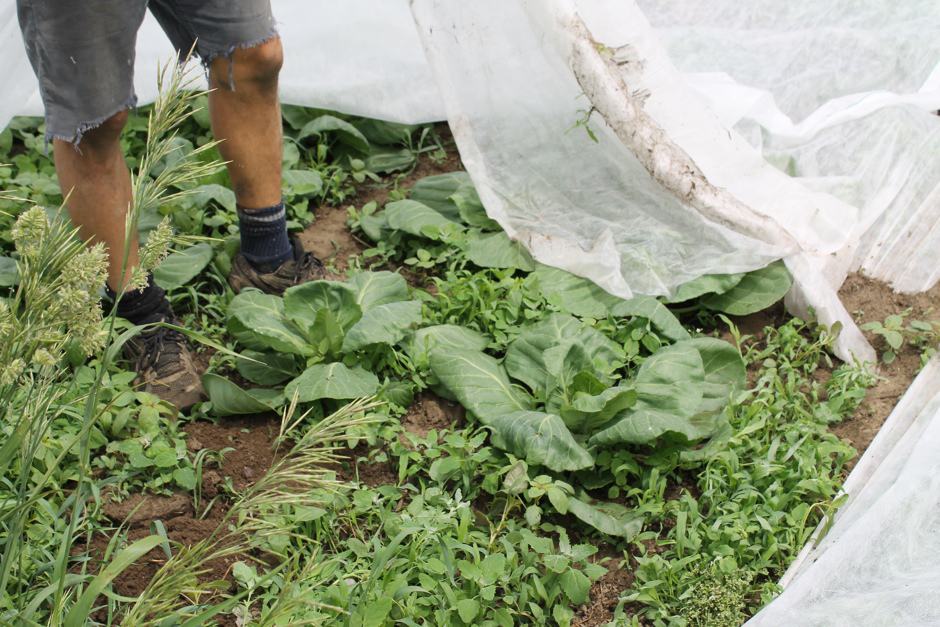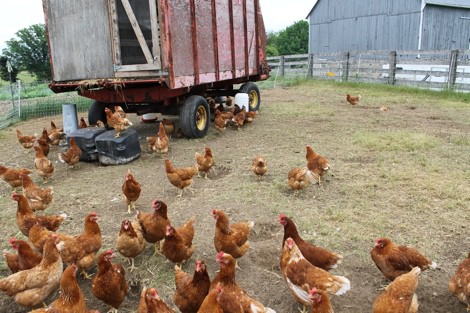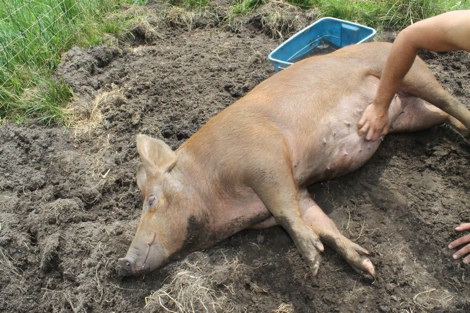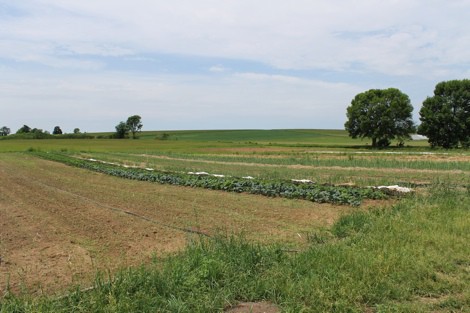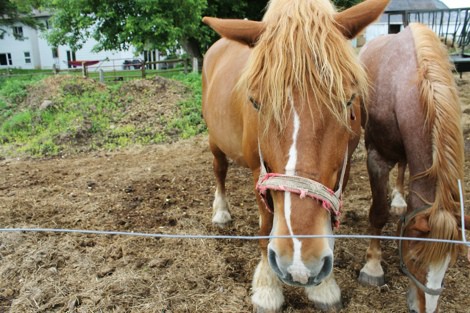“Watch out for landmines,” Niall Stocking said, nodding towards manure on the ground as he walks through a field located in Uxbridge, Ontario. Located an hour and a half drive from downtown Toronto, Willo’ Wind farm is operated by brothers Adrian and Niall Stocking and their family. Niall manages the livestock, while Adrian is responsible for the agricultural side of the operation.
At the core of the brothers’ farming philosophy is the concept of sustainable farming — a notion that often finds itself at the heart of contemporary debates about food production, processing, and the journey our food takes from the farm to our tables.
Building sustainability
Fresh produce in North America travels an average of 3,000 kilometres from its point of origin to its point of sale. Food grown at Willo’ Wind travels a fraction of that distance. However, as the brothers share, achieving true sustainability is an ongoing process.
“It’s a toss-up,” Adrian explained “There are some things we have to use on the farm that aren’t sustainable.” This includes the fuel used to transport produce to market, and items such as row cover — a fabric-like material used to shield plants from pests.
“We’re constantly trying to work towards being more sustainable, saying that ‘okay, this is a compromise we have to make now, but how in the future can we make things better,’” said Adrian. Niall agreed, “We’re sustainable, but we’re not off the grid.”
While there is some variation in the definition of sustainable farming, for Adrian, the concept is quite simple. “What it means is that it can continue on,” he said, “The method of production can go on and on.”
Willo’ Wind’s dedication to preserving the fertility and viability of the land — a cornerstone of sustainable farming — is different from the approaches taken by many conventional farms. Adrian explained, “Comparing [sustainable practices] to industrial agriculture, what we’re trying to do is build the soil so that the soil will grow the plants, whereas industrial agriculture will feed the plant and not really give a shit about the soil. Like I said, for industrial farmers it’s about short-term gain; as long as you’re getting so much out, it doesn’t really matter.”
This awareness and focus on the preservation of the land is closely related to the livestock side of the farm as well. Many of the animals at Willo’ Wind will be processed and sold as meat; however, they also play a role in developing the land.
“I’m working with the animals natural habits to increase the fertility of the farm,” said Niall. His goal is to develop a cycle that integrates the animals into the process of working the land. “Ideally, once I get some cows, I’ll do a big pasture, put the cows on it, take them off, put the pigs on it, and then put the chickens on it. It does take a heck of a lot longer [than industrial farming] though.”
For Niall, the careful planning and extra time is worth it. He said, “I went to an organic conference where they showed [us] the difference between soil where animals were integrated into the [farming] system and soil where they weren’t. The soil where the animals were involved was much richer.”
You are what you eat
One upside of buying locally sourced food is being able to understand how the product was produced. “If people think of their meat as coming from the grocery store, they’re not going to care about the pork chop’s life. But if they know that pork chop came from an animal that had a life, they might actually care about how that animal lived,” said Niall.
The conditions experienced by animals at conventional farms are often starkly different from those at smaller farming operations. Cases in Canada have documented abusive environments at large-scale egg and turkey farms. While these conditions are not present in all industrial farms, the pressure for profits requires compromises to be made on the space and individual attention afforded to the animals.
Willo’ Wind has a different perspective. Mid conversation, Niall excused himself to spray the piglets with water from a hose, enabling them to wallow in the mud. “A conventional farmer wouldn’t be standing here doing this — it’s a waste of time. Eventually I’d like to set up something automatic.” When asked why he puts in the added effort, he responded, “Because they like it.”
Niall kneels down next to one of the piglets, “See how this one has a scar on his leg? It [happened the day he was born, [his mother] stepped on him. Most conventional places would have killed him right there [and] saved the loss. But I doctored him; he’s a bit smaller than everyone else, and will always be a bit smaller, but he has the chance to have a bit more of a life. There’s less waste.”
The farm sells pork, turkey, chicken, and eggs — and with such a small operation, buyers know who has been handling their food during production. Eggs are processed on the farm. “We collect them, go through each egg, wash each egg, and grade each egg,” says Niall. Pork and poultry are sent off-site to a government-certified abattoir for processing.
Growing organic
“Farming’s a very un-exact science. There’s a lot of science to it, but there are a lot of variables that you’re constantly having to adapt to,” said Adrian. For any farmer, the main culprits are weather, pests, and weeds. For sustainable, organic farmers like the Stockings, the challenge is two-fold; dealing with the challenges without the use of conventional fertilizers and pest control methods. According to Adrian, the secret is knowing your enemy.
Since the farm doesn’t employ pesticides or synthetic fertilizers, they have to be more creative in their pest control solutions, which often includes considering the weaknesses of individual crops and pests. Adrian provides an example, “There’s a pest called the Colorado potato beetle. Everybody usually starts planting their potatoes in May, we planted ours [in mid-June]. Everybody’s are up right now, and the potato beetles are flying around and landing on the potatoes, laying their eggs and starting to reproduce. And then [later] mine will come up, and I’ve missed the whole first wave [of pests].”
Other strategies used by the farm include physically covering the crops with a protective fabric called row cover, and trap cropping. As Adrien explained, trap cropping involves planting a crop that is particularly attractive to pests nearby in order to distract pests from the crop he wants to survive.
The strategies, however, aren’t always successful, “I’ve lost a lot of crop — I lose crop all the time,” he says. The odd of success are often based on the plant itself, “The healthier the plant the more it’s going to be able to defend itself against pest pressure. When plants are stressed out, they almost give off this signal that attracts pests. It’s kind of weird, and hard to believe, but there is some science behind it.”
The farm produces a variety of vegetables, sold at farmers markets in the GTA and Toronto area, including the Junction Market on Dundas Street West. The best sellers, however, are still what Adrian refers to as the classics, “Carrots, lettuce, onions, tomatoes. But then you take kale for example; it’s kind of a staple vegetable now. [But] five years ago I would take kale to market and I would sell maybe six bunches of kale, now I sell 40.”
Buying locally sourced food is a different experience than visiting a grocery store. According to Adrian, “The thing with the local food movement and farmers markets is that it encourages people to try new vegetables. If you go to a supermarket and you have all the vegetables laid out, and you have Bok Choy and Napa cabbage and other random things, people are likely to go for their regular [choices]. But the same spread at a farmer’s market with someone there, like the farmer, recommending things — you’re more likely to try different vegetables.”
The roots of farming
A part of Willo’ Wind’s philosophy is give individuals the opportunity to experience and understand sustainable farming. They open the farm to volunteers looking to help with harvesting for a day or two, as well as participating in the World Wide Opportunities on Organic Farms program (WWOOF). They also offer apprenticeships through the Collaborative Regional Alliance for Farmer Training (CRAFT). The apprenticeship lasts six months — interns are expected to put in 50 hours of labour per week, equating to five ten-hour days in exchange for room and board and a monthly stipend.
For Niall and Adrian, the job is a constant commitment involving 4 am mornings, and working well into the night. Some of the jobs, like plowing some of the fields with horses instead of a tractor, take a lot of extra time, but they consider these tasks worth the labour. Niall said, “It’s a lot more satisfying when I work with the horses, it’s more of a bond I guess, it’s the three of you working together to plow the field, not just you and the tractors.”
Still, the time and effort it takes to commit to organic, sustainable farming is a challenge. Adrian, who has a background in advocacy work, said his passion for issues surrounding sustainability got him into the farming business, “I was living in Vancouver and I started getting involved in issues around food and sustainable farming, and for me it was a lot of talking but no solutions. I didn’t really know how effective I was, advertising causes without providing a substantial alternative — which led me to think more about farming.”
A commitment to providing that substantial, sustainable alternative was a big part of his decision to farm, but not the only factor. He added, “The other part is that I really love food, so I really love getting to go outside and having six acres of vegetables to snack on.”

